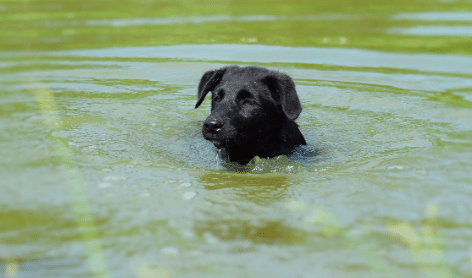With the summer months just around the corner, the coming heated temperatures make us look forward to spending time outdoors with our four-legged best friends. But there is one outdoor danger that most pet owners don’t realize is actually a major danger to their precious furbabies. And that would be a spike in blue-green algae cases.
What is Blue-Green Algae
So, what exactly is blue-green algae? And more importantly, what makes is so toxic? Blue-green algae is actually cyanobacteria, and it thrives in freshwater bodies when the weather is warm and sunny – roughly around the 75 degrees mark. Because of this, most algae poisonings happen during the summer months due to the weather conditions being perfect for cyanobacteria to flourish. These organisms are very, very toxic and they pose a great threat to the welfare of not just dogs, but also cats, wildlife, livestock, birds, and even fish. Cyanobacteria can even pose a threat to humans!
So, when it comes to the dangers of toxic algae, how can you tell which water is safe, and which water should be avoided? Well, for starters, most water that is infested with toxic algae blooms will often be a pea-green hue in color or will appear to be slimy on the water’s surface. It should also be noted, that if there are strong enough winds, most of those algae blooms will often be pushed into clusters around the shoreline area – where most animals will often be drinking or swimming.
If you are out with your pet and you suspect that your dog may have come in contact with blue-green algae, either by swimming in or drinking a contaminated water source, then you need to get them to the vet. Toxic algae poisoning can result in severe neurologic or liver damage.

Below Are the Symptoms of Algae Toxicity to Watch Out For:
• Seizures
• Panting
• Excessive drooling
• Respiratory failure
• Diarrhea
• Disorientation
• Vomiting
• Liver failure
• Ultimately death
Should your dog start exhibiting signs of algae poisoning, then get them immediately to a veterinarian.
The best defense against algae poisoning is to be vigilant. When you’re out with your pet, be wary and don’t let them drink from stagnant ponds, lakes or other fresh bodies of water – especially if these have any signs of having a bluish-green scum on the water’s surface or near the edges.
Blue-green algae blooms can also get stuck to your pet’s coat, which will later pose a danger when they’re grooming themselves as that’s a way for them to ingest the toxins. Therefore, before you let your dog go swimming in freshwater, watch out for the signs. Also, if your dog does take a dip, make sure you thoroughly wash them after being in freshwater.
There are many public health departments who will often go and test different water bodies in your area and will often post signs to warn the public about outbreaks. That is why it’s important to stay alert and look out for signs – they may save your dog’s life.
Should your dog come in contact with toxic algae, immediately get in contact with your vet or with the ASPCA Animal Poison Control Center on 888-426-4435.











